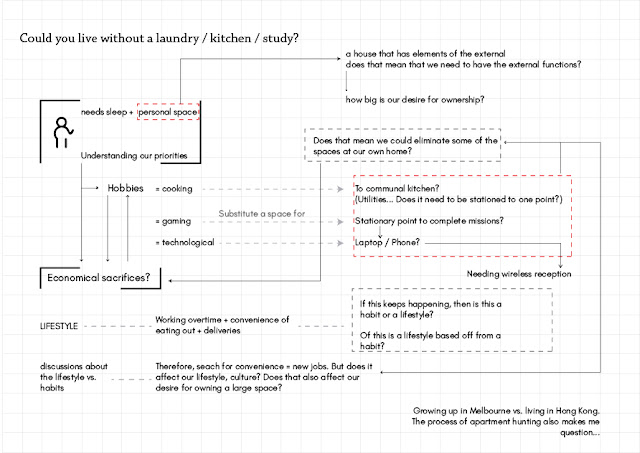Architecture for the Homesick 101: Are You Sure You Need A Kitchen or a Laundry?
“I believe that we might not even need kitchens in the future given that there’s Ubereats and Deliveroo”
Last year. during our studio class (Studio Shared) - our group’s assignment challenged the ownership of a house - how much one should have or want to possess. Essentially, it was very much like an IKEA catalogue of pick and choose the elements for your house considering that your necessities such as a bathroom, communal kitchen, toilet or laundry were highly accessible as it was a foreseeable trend of the future. Albeit, despite having these facilities available publicly, our house still retained the nuclear house: a kitchen, a sink, a bed and plenty of storage. It was also very reminiscent of my other studio project I did during first year with my partner, where we also designed another IKEA flat pack type design that offered residents to build cells of what they would like to have in their own home should their area become flooded.
It is interesting, to observe each of our own definitions of a “home”. Among some of my friends, we argued that we need a kitchen, as it was the ‘heart’ of the house (as well as not the best Feng Sui placement) as well as a bathroom, toilet, etc. In other words, the definition of a house is an external reflection of the habits and personality of the individual, couple otherwise family would need for themselves and to be happily call their own.
Having stayed in Hong Kong for a couple of months, I had the experience of living in two very different spaces: Government housing and an apartment built from the late 1990’s. Both of these spaces had strong juxtaposition in size that depended on what my relatives owned and shared. For me, living out of a suitcase was definitely an experience, albeit it put a perspective of small if not living minimally.
Thanks to the rising trend of small living that could be easily witnessed from the television (thank you Nine Life!) coupled with the common Instagram aesthetic of minimalism and living minimally but also sustainably slowly growing - it is more accessible for those who have been living majority of their lives in large homes to see that it is possible to adapt into small living. Arguably, the aesthetics and the sharing of creative ideas has also made the concept of living small rather enticing and attractive. Personally, from watching episodes of tiny living, it leaves me questioning about the longevity as well as the sustainability of living small. Of course, how these spaces are maintained will depend on the owner, however it also depends on the type of lifestyle one would have to choose.
During my stay in Hong Kong - my weekends were clustered with outdoor plans and dates with myself otherwise with my relatives and friends. It was easy to understand why I was expected to be outdoors - the amount of clutter we own was palpable (not to mention windows that would potentially peer into each other) and it forces us to escape from the growing claustrophobic environment. I often found myself drawn to the SOHO areas, otherwise casually strolling through the steep hill to observe the buildings, Avery otherwise the mountains from afar. It was enjoyable however, the kind of lifestyle with the expectation and culture of being out majority of the weekends was not something I was accustomed to considering I have always been indoors and enjoying my internal hobbies despite the kind of space I was surrounded with.
With that said, during a conversation with an architect, when we were discussing about one of his completed works of an apartment interior, I questioned about the future of Melbourne’s living given the transitional shift of increasing apartment blocks. There was a lot of food for thought, given that the rise and increasing dependence on efficiency and given space limitations - it can condition one to question whether it was necessary to live with a large space at the first place.
Personally, I’d like to think that the type of houses that we live in now was a model for efficiencies in many ways. Should we reflect back on living conditions in the past, there were public baths, laundromats and communal kitchens - these shared amenities were for everyone to use under different circumstances. However, these facilities have slowly diminished over time and broken down to be encompassed in a house, reducing time for some to travel to the required facilities. Of course, this is one contradictory theory given that houses and homes in the past already have those facilities, the ones for public use were for a different kind of lifestyle. On the other hand, it could be argued that culturally, different regions adapted to different style of living to begin with. Times have changed technologically and culturally - the growing amount of shared facilities has also given options to opt out of different 'necessities' we really need in a home.
Although, it could be argued that living efficiently and sustainably comes down to economical efficiency, as well as whether one if willing to spend their finances in using a laundromat or public baths rather than having those options at home.
Perhaps then, our kind and quality of living would depend on how one would operate in their everyday life in conjunction with their needs. I could slowly see why the kitchen is almost non-existent in the apartments in Hong Kong - working hours were already eating into dinner time, also how could we not resist eating out when restaurants are right next to work and costs less in comparison to cooking for ourselves? The high humidity percentage also affects many’s preference to turn their laundry to a laundromat in favour of having the extra space the large washing machine would have occupied. I could also see how easy it was for us to constantly be out an about on weekends, considering that my aunt’s next door neighbour’s lounge was simply a nursery for their daughter - at her age where her mind is constantly changing, it wasn’t surprising to observe how a quick change in age essentially calls for a change in furniture type, otherwise materials to accommodate her learning age.
Ultimately, to question whether it is possible to adapt to small living - it would take one’s habits, personality and lifestyle to determine the factor. How we live really, I believe largely affects our view in the space we live in otherwise how we would like to make the most of the space. Given from my experience of the both, I have to admit that living out of a suitcase has conditioned me to consider how much I should own and differentiate what I need from what I want. At least I can confidently say that I can live in a small apartment so long as there’s convenient access to transportation.
But I don’t think I can give up on the idea of living without a kitchen just yet.
Related articles:
Adventures of Studio Shared: Part I, II, III, IVMAIO - Kitchenless City
Four Walls, One Gone
TA Square - Buckingham Micro Unit








Comments
Post a Comment